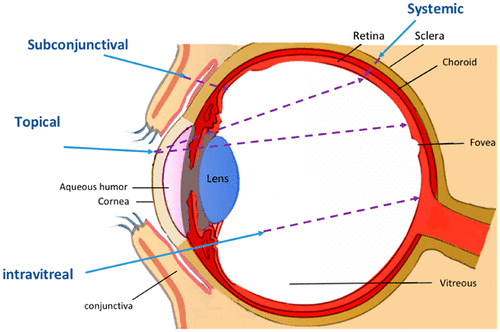当前位置:
X-MOL 学术
›
Mol. Pharmaceutics
›
论文详情
Our official English website, www.x-mol.net, welcomes your
feedback! (Note: you will need to create a separate account there.)
Nanoparticulate Drug Delivery to the Retina
Molecular Pharmaceutics ( IF 4.5 ) Pub Date : 2020-06-05 , DOI: 10.1021/acs.molpharmaceut.0c00224 Qingqing Li 1 , Jingwen Weng 2 , Si Nga Wong 2 , Wai Yip Thomas Lee 3 , Shing Fung Chow 2
Molecular Pharmaceutics ( IF 4.5 ) Pub Date : 2020-06-05 , DOI: 10.1021/acs.molpharmaceut.0c00224 Qingqing Li 1 , Jingwen Weng 2 , Si Nga Wong 2 , Wai Yip Thomas Lee 3 , Shing Fung Chow 2
Affiliation

|
Retinal diseases, such as age-related macular degeneration and diabetic retinopathy, are the leading causes of blindness worldwide. The mainstay of treatment for these blinding diseases remains to be surgery, and the available pharmaceutical therapies on the market are limited, partially owing to various biological barriers in hindering the delivery of therapeutics to the retina. The nanoparticulate drug delivery system confers the capability for delivering therapeutics to the specific ocular targets and, hence, potentially revolutionizes the current treatment landscape of retinal diseases. While the research to date indicates the enormous therapeutics potentials of the nanoparticulate delivery systems, the successful translation of these systems from the bench to bedside is challenging and requires a combined understanding of retinal pathology, physiology of the eye, and particle and formulation designs of nanoparticles. To this end, the review begins with an overview of the most prevalent retinal diseases and related pharmacotherapy. Highlights of the current challenges encountered in ocular drug delivery for each administration route are provided, followed by critical appraisal of various nanoparticulate drug delivery systems for the retinal diseases, including their formulation designs, therapeutic merits, limitations, and future direction. It is believed that a greater understanding of the nano-biointeraction in eyes will lead to the development of more sophisticated drug delivery systems for retinal diseases.
中文翻译:

将纳米颗粒药物输送到视网膜
视网膜疾病,如年龄相关性黄斑变性和糖尿病性视网膜病变,是全球失明的主要原因。这些致盲疾病的主要治疗方法仍然是手术,市场上可用的药物疗法是有限的,部分原因是各种生物障碍阻碍了治疗药物向视网膜的传递。纳米颗粒药物输送系统赋予了将治疗药物输送到特定眼部目标的能力,因此有可能彻底改变当前的视网膜疾病治疗格局。虽然迄今为止的研究表明纳米颗粒递送系统具有巨大的治疗潜力,但这些系统从工作台到床边的成功转化具有挑战性,需要对视网膜病理学的综合理解,眼睛的生理学,以及纳米粒子的粒子和配方设计。为此,本综述首先概述了最常见的视网膜疾病和相关药物治疗。重点介绍了目前眼部药物递送在每种给药途径中遇到的挑战,然后对用于视网膜疾病的各种纳米颗粒药物递送系统进行了批判性评估,包括它们的配方设计、治疗优点、局限性和未来方向。人们相信,对眼睛中纳米生物相互作用的更深入了解将导致开发更复杂的视网膜疾病药物输送系统。审查首先概述了最普遍的视网膜疾病和相关药物疗法。重点介绍了目前眼部药物递送在每种给药途径中遇到的挑战,然后对用于视网膜疾病的各种纳米颗粒药物递送系统进行了批判性评估,包括它们的配方设计、治疗优点、局限性和未来方向。人们相信,对眼睛中纳米生物相互作用的更深入了解将导致开发更复杂的视网膜疾病药物输送系统。审查首先概述了最普遍的视网膜疾病和相关药物疗法。重点介绍了目前眼部药物递送在每种给药途径中遇到的挑战,然后对用于视网膜疾病的各种纳米颗粒药物递送系统进行了批判性评估,包括它们的配方设计、治疗优点、局限性和未来方向。人们相信,对眼睛中纳米生物相互作用的更深入了解将导致开发更复杂的视网膜疾病药物输送系统。包括它们的配方设计、治疗优点、局限性和未来方向。人们相信,对眼睛中纳米生物相互作用的更深入了解将导致开发更复杂的视网膜疾病药物输送系统。包括它们的配方设计、治疗优点、局限性和未来方向。人们相信,对眼睛中纳米生物相互作用的更深入了解将导致开发更复杂的视网膜疾病药物输送系统。
更新日期:2020-06-05
中文翻译:

将纳米颗粒药物输送到视网膜
视网膜疾病,如年龄相关性黄斑变性和糖尿病性视网膜病变,是全球失明的主要原因。这些致盲疾病的主要治疗方法仍然是手术,市场上可用的药物疗法是有限的,部分原因是各种生物障碍阻碍了治疗药物向视网膜的传递。纳米颗粒药物输送系统赋予了将治疗药物输送到特定眼部目标的能力,因此有可能彻底改变当前的视网膜疾病治疗格局。虽然迄今为止的研究表明纳米颗粒递送系统具有巨大的治疗潜力,但这些系统从工作台到床边的成功转化具有挑战性,需要对视网膜病理学的综合理解,眼睛的生理学,以及纳米粒子的粒子和配方设计。为此,本综述首先概述了最常见的视网膜疾病和相关药物治疗。重点介绍了目前眼部药物递送在每种给药途径中遇到的挑战,然后对用于视网膜疾病的各种纳米颗粒药物递送系统进行了批判性评估,包括它们的配方设计、治疗优点、局限性和未来方向。人们相信,对眼睛中纳米生物相互作用的更深入了解将导致开发更复杂的视网膜疾病药物输送系统。审查首先概述了最普遍的视网膜疾病和相关药物疗法。重点介绍了目前眼部药物递送在每种给药途径中遇到的挑战,然后对用于视网膜疾病的各种纳米颗粒药物递送系统进行了批判性评估,包括它们的配方设计、治疗优点、局限性和未来方向。人们相信,对眼睛中纳米生物相互作用的更深入了解将导致开发更复杂的视网膜疾病药物输送系统。审查首先概述了最普遍的视网膜疾病和相关药物疗法。重点介绍了目前眼部药物递送在每种给药途径中遇到的挑战,然后对用于视网膜疾病的各种纳米颗粒药物递送系统进行了批判性评估,包括它们的配方设计、治疗优点、局限性和未来方向。人们相信,对眼睛中纳米生物相互作用的更深入了解将导致开发更复杂的视网膜疾病药物输送系统。包括它们的配方设计、治疗优点、局限性和未来方向。人们相信,对眼睛中纳米生物相互作用的更深入了解将导致开发更复杂的视网膜疾病药物输送系统。包括它们的配方设计、治疗优点、局限性和未来方向。人们相信,对眼睛中纳米生物相互作用的更深入了解将导致开发更复杂的视网膜疾病药物输送系统。











































 京公网安备 11010802027423号
京公网安备 11010802027423号